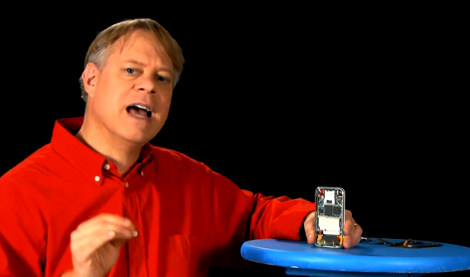There’s a good chance that you use a MEMS accelerometer every single day. It’s the small chip that let your smart phone automatically adjust its screen orientation. They’re great chips, and since they’re mass-produced you can add them to your projects for a song (if you can abide the tiny packaging). But we have no idea of how they are made and only a inkling of how they work. [Bill Hammack] has filled that knowledge gap with this explanation of how MEMS accelerometers are made and how they function.
Our base knowledge comes from the acronym: Micro Electro-Mechanical Systems. There’s something in the chip that moves (so much for solid state electronics; and it makes us wonder if these wear out). [Bill] includes a diagram in his video after the break which shows the silicon-based system that moves as it is affected by gravity. This changes the capacitive properties of the structure, which can be measured and reported to a microcontroller for further use. The structure is built using an intricate etching process which we never want to try out at home.
Looking for a project in which to use one of these devices? We’ve always been fond of this POV device.

















>>>and it makes us wonder if these wear out
No, the moving parts are designed to stay below the fatigue limit. See http://www.lbl.gov/ritchie/Programs/MEMS/Fatigue.html
However, due to electrostatic forces being so strong at the microscale, a large enough acceleration could cause one of the moving parts to make contact with another surface and stick. ie, drop your phone and the sensor will stop working. Manufacturers generally publish the g-limit.
Memsic make true solid state accelerometers, in the sense that there are no moving solid parts. The reference mass is a heated bubble of fluid and there is no practical upper limit to the shock they can survive making them good for guided projectiles. They look like regular accelerometers except they have a metal lid on the package.
Memsic uses a heated bubble of air doesn’t it?
So yes, solid state, but the knock is current draw on this design vs. the analog part.
I just love this guy! (no homo)
His explanations of complex machines are both simple and detailed.
Great presentation. Takes a complex idea and makes it very accessible.
Now I’m so sad :) I never even handled a device to make the display follow the devices orientation, much less on a daily basis.
sure you did, its called a car :D
Another great video from the E-guy. I love it.
E-guy for president.
in the absence of Carl Sagan that is.
Hard to decide. Only one way to settle this…
!!!THUNDER DOME!!!
Two men enter..
…In this case, two men would leave because both are pacifists and overly qualified when tasked with escaping a rusty cage built by radiation stricken post apocalyptic feces farmers.
Makes me wonder how difficult it would be to make an accelerometer with some aluminum foil (just as a demonstration).